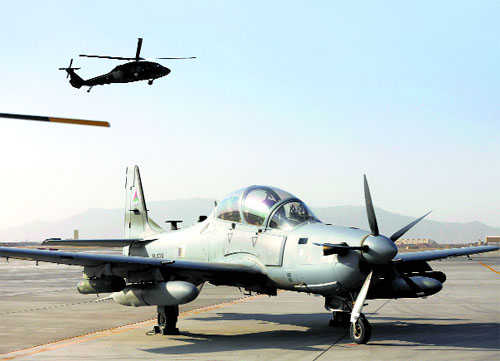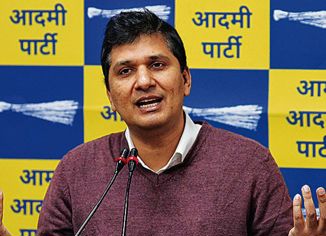
A handover ceremony of Blackhawk copters from the US to Afghan forces in Kandahar on Oct 7. REUTERS
Arwin Rahi
In 1838, the governor-general of India Lord Auckland declared war on Afghanistan, triggering the first Anglo-Afghan War. The East India Company, in tandem with the ruler of Punjab, Maharaja Ranjit Singh, launched a two-pronged invasion of Afghanistan-through the Khyber and Bolan Passes.
The objective was to unseat the Afghan ruler, Amir Dost Mohammad Khan, whom the British accused of collusion with the Russians, and replace him with Shah Shuja ul-Mulk. The invasion was executed swiftly. Except Ghazni, no Afghan city put up much of a resistance. In August of 1839, Shah Shuja ul-Mulk was installed on the throne of Kabul, with British bayonets. The following year, the dethroned Amir Dost Mohammad Khan surrendered to the British, and was sent to India as a hostage.
Initially, everything seemed to have been under control. But it was only a matter of time before the whole country would rise in rebellion. To make matters worse, the British lacked the experience and knowhow to occupy a country with complex tribal rivalries and rough terrain that didn't generate much revenue.
Things came to a head in December 1841, when the British envoy William Macaghten (or the de facto ruler of Afghanistan) was assassinated by Wazir Mohammad Akbar Khan, who led the uprising in Kabul. In the following month, an entire British army numbering 16,500 (4,500 troops and 12,000 camp followers) was destroyed in the passes and gorges between Kabul and Jalalabad.
In April 1842, General Pollock, leading the Army of Retribution, forced through the Khyber Pass to relieve the British garrison at Jalalabad and recapture Kabul. To avenge the massacre of British troops, General Pollock briefly occupied and burned down parts of Kabul and Istalif, a village to the north of Kabul.
However, the new governor-general of India, Lord Ellenborough, ordered the British troops to evacuate Afghanistan before the cold weather set in. The following year, Wazir Mohammad Akbar Khan received his father Amir Dost Mohammad at Ali Masjid, and escorted him up the Khyber Pass to Kabul to assume his throne as the Afghan ruler. The First Anglo-Afghan War was therefore considered the single largest military catastrophe for the British Empire in the 19th century.
FIRST ANGLO-AFGHAN WAR PATTERN
The First Anglo-Afghan War set up a pattern that would be followed in subsequent invasions of Afghanistan. The pattern has four phases: First, swift invasion and occupation of Afghanistan without much resistance; second, resistance to foreign forces increases with the passage of time; third, the war is condemned to a stalemate; fourth, withdrawal (or retreat) of foreign troops.
The events of the Second Anglo-Afghan War 1879-1880, the Soviet war 1979-1989, and the US and NATO mission in Afghanistan corroborate the statement. It is interesting that each one of these three military adventures was headed by a superpower of its time, and each one of these military adventures followed the pattern of the First Anglo-Afghan War.
16 years ago in October, the US launched its invasion of Afghanistan. With America's Afghan war entering into the 17th year, the First Anglo-Afghan War offers stark lessons. Although there are visible differences between the two wars, the four-phased pattern in both wars remains the same. First, the US invasion of Afghanistan was swift. Second, resistance to US military presence grew over time. Third, American officials have publicly admitted that there is a stalemate on the battlefield. Fourth, the US has largely withdrawn its troops from Afghanistan, and the remaining troops no longer operate in a combative capacity. In a face-saving effort, the US has encouraged negotiations with the Taliban. Back in 2001, things were different.
When in December that year, Hamid Karzai suggested to US Defense Secretary Donald Rumsfeld that Mullah Omar wanted to retire to a local village in Kandahar in exchange for a safe exit from Kandahar City, Donald Rumsfeld rejected Hamid Karzai's suggestion. Now it's proving challenging to bring the Taliban to the negotiating table. The US embarked on a costly war to topple the Taliban regime, but it is very likely that the same war will come to an end after the US-backed Afghan government reaches some sort of power-sharing agreement with the Taliban. Or even worse, if the US abandons Afghanistan once again (as it did after the end of the Cold War) and Afghanistan's neighbours and major regional powers like China and Russia do not reach an agreement about the future of the country, it is very likely that the Taliban might overrun much of the country again.
Then one could argue that the very war that was launched to topple the Taliban, has come to an end after power was restored to the Taliban. Everything will be back to square one.
REGIONAL CONSENSUS ON AF FUTURE
History suggests that Afghanistan enjoyed periods of stability when competing powers' interests were not on a collision course in Afghanistan.
The Tsarist Russia and British India agreed on a buffer state status for Afghanistan. As a result, even though Afghanistan's foreign affairs were under British supervision, the country was generally peaceful and stable from 1880 to 1919. Later, during the two World Wars and first three decades of the Cold War, Afghanistan, unlike its immediate western and eastern neighbours, remained neutral.
Afghanistan's neutrality preserved a ‘Balance of Interest’ (BOI) between major powers.
Forces of chaos and instability were unleashed when the BOI was upset as a result of a Communist coup in 1978. The Soviet Union not only did not help to restore the BOI, but totally destroyed it when it invaded Afghanistan in 1979.
Peace and stability will return to Afghanistan when the BOI is restored again. However, the longer the Afghan war drags on, the more complicated will it get, and the more difficult will it be to restore that balance.
Certainly the US presence will not help mitigate the crisis. The US has lost regional support for its presence in Afghanistan. It is fair to say that except India, no other country in the region wants to see US troops in Afghanistan anymore.
When that's the case, it is likely that the countries that remain opposed to US presence in Afghanistan will work (together if possible) to make life harder for the US. The total withdrawal of US troops will help tremendously with restoring the BOI in Afghanistan, providing regional players prevent a total collapse of state institutions.
That being said, the good news is as we move from a unipolar world, (with the US as the only global power) to either a bipolar (the US and China as world powers), or a multipolar world, the chances of restoring the BOI through a regional consensus will increase. Peace and stability in Afghanistan will further facilitate regional connectivity, trade, and tourism between South and Central Asia, and the Middle East and East Asia.
Pakistan, Iran, China, Russia, and to an extent India are in a better position than the US to work with Afghanistan to find a long-term, sustainable solution to the Afghan war.
By arrangement with the Dawn






















